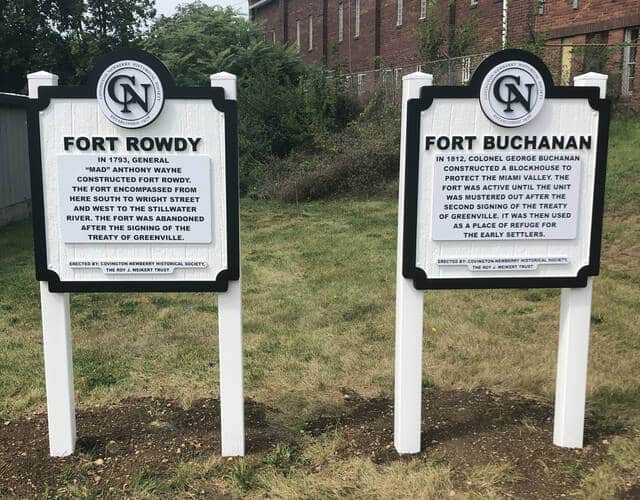
The Covington-Newberry Historical Society and the Roy J. Weikert Trust recently installed their second and third historical markers in the village of Covington to designate the location of Fort Rowdy and Fort Buchanan.
Provided photo
For the Miami Valley Today
COVINGTON — The Covington-Newberry Historical Society and the Roy J. Weikert Trust installed their second and third historical markers in the village of Covington.
The markers designate the location of Fort Rowdy and Fort Buchanan. The location of these two forts were in the area of the Covington VFW Memorial Post 4235 who gave permission to install them to the north of their post. Earlier this year, the first historical marker was placed on Buffalo Jack’s restaurant. The VFW post is located at 173 N. High Street.
Fort Rowdy encompassed the area west from present-day High Street to the Stillwater River south from the area of the VFW to present-day Wright Street. This area included a never ending artesian well, which is still located in the south parking lot of the VFW.
The 1933 Greenville Daily Advocate gave a very descriptive article about Fort Rowdy, which was built by General “Mad” Anthony Wayne in 1793. It read, “This fort was constructed of heavy hewn logs, the first floor containing the munitions and supplies protected by a wall of stone and earth thrown up around it. The second floor projected over about three feet on all sides, being supplied with loopholes and opening through which the soldiers could fire in case of an attack from hostile Indians, and this, with the additional protection of the stockade, made it possible for this small number of soldiers to ward off all attacks.”
After the signing of the Treaty of Greenville in 1795, the fort was no longer used by the military.
Fort Buchanan was a stockade that was built in the area of the former Ohio National Guard armory. Just inside the entrance to the building is a memorial plaque placed there by the descendants of Captain George Buchanan.
Leonard Hill, noted Miami County historian, wrote a history of Fort Buchanan in the Piqua Daily Call in 1968. He stated that Captain George Buchanan formed the first company of the 2nd Regiment of the 5th Brigade of the 1st Division of the Ohio Militia. The main purpose was to protect the frontiers since the Indian boundary line was only 15 miles north of Piqua.
Captain George Buchanan established Buchanan’s blockhouse on the east side of the Stillwater River about opposite the mouth of Greenville Creek. On several occasions, Buchanan was dispatched to assist Indian Agent John Johnston in Piqua. Upon the conclusion of the War of 1812, the fort was no longer used by the militia. Settlers would use it for refuge.
The Covington-Newberry Historical Society operates a museum at 101 East Spring St., which is open the first and third Sunday and the second and fourth Wednesday of each month. Also, the museum will be open Labor Day weekend.
The Roy J. Weikert Trust was established by Roy J. Weikert, the founder of General Films a plastic manufacturing plant located in Covington. Weikert was a pioneer in the plastic film industry and holds several patents for plastic.
They would like to thank the officers and members of the Covington VFW Memorial Post #4235 for allowing the placement of the historical markers on their property.


